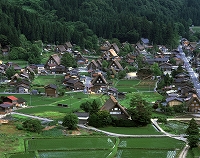Energy / Climate Change
April 9, 2008
Fluorescent Bulbs Replace Incandescent in World Heritage Site Buildings to Reduce CO2 Emissions
Keywords: Climate Change Energy Conservation Local government Manufacturing industry

Copyright the Shirakawa village office
The project was supported by Matsushita Electric Industrial Co., which donated over 700 of its efficient fluorescent bulbs, called the Palook Ball Premiere, to replace 537 incandescent bulbs in Shirakawago's 90 houses and 165 in Gokayama's 35 houses. The conversion will help the two villages reduce their energy related carbon dioxide (CO2) emissions by about 24 tons per year.
The communities in this area, which is surrounded by steep mountains and covered by deep snow in winter, developed a unique lifestyle and architecture, including the Gassho-zukuri houses, to coexist wisely with nature. The Gassho-zukuri villages in Shirakawa-go and Gokayama were listed as World Heritage sites in 1995, honored for their preservation of traditional culture and architecture designed to be in harmony with the surrounding environment. At twilight, when the lights are turned on in the houses with their characteristic triangular roofs, the villages take on a mystical appearance.
Posted: 2008/04/09 05:51:19 PM
Related
"JFS Newsletter"
- Shaping Japan's Energy toward 2050 Participating in the Round Table for Studying Energy Situations
- Implementation of the Paris Climate Agreement: A Report on Japan's Round Table for Studying Energy Situations
- Auto Sales Industry Cooperates to Tackle Social Responsibility: Examples from Yamagata, Japan
- Yokohama FC: Leader in Eco-Activities through Football-Related Carbon Offset
Related
"Popular Articles"
- Large Ozone Hole Observed Again in 2011
- Japan's Pro Baseball Teams Start Eco-Project to Cut Energy Use by 6%
- Manufacturer Saving Energy by Growing Vertical Gardens on Factory Walls
- Sony Draws Up 'Road to Zero' Plan for Zero Environmental Footprint
- Tokyo Announces Innovative 10-Year Strategy against Climate Change


